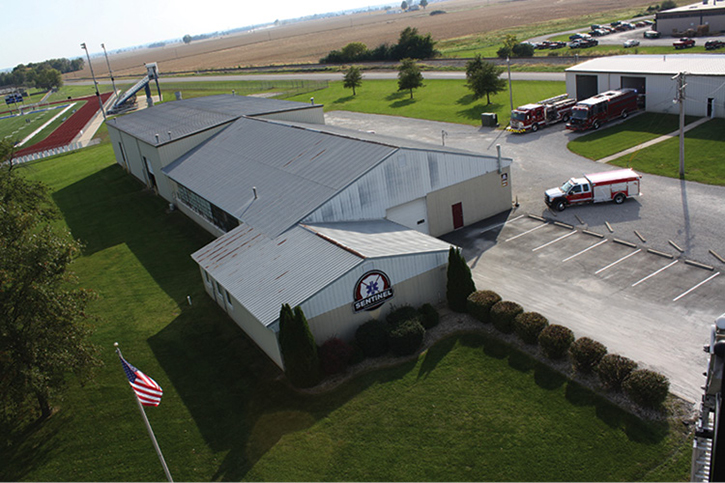
BY BILL ADAMS
In the latter part of 2020 when the final caravan of moving vans and fire trucks rolls down Telegraph Road in Missouri’s St. Louis County, Bill Franz and wife Norma will breathe a sigh of relief. A journey lasting more than three decades that started with their selling fire equipment out of their house will culminate in a new 33,000-square-foot facility.
Sentinel Emergency Solutions, LLC, will have a new home. Encompassing buyouts, closures, consolidations, moves, and name changes, the Franz family’s trek peddling fire equipment is an interesting tale. Bill, son Brian, and daughters Amy Franz-Schipper and Cindy Franz-Hake were interviewed for this article. Franz-Hake says, “As with most family businesses, all the Franz children were involved from counting helmet crescent decals during inventory to copying truck specifications sheet by sheet on the old-style copying machines to answering the ‘business’ telephone located in our kitchen. We grew up in the fire equipment business.” They’re still in it.
Related Content
THE START
Bill Franz and two coworkers employed by a Chicago, Illinois, based fire equipment company realized the business was experiencing difficulties and declining. In 1986, they left and started their own company, becoming equal owners of Battalion Three, Incorporated, working out of one of their homes. Several years later, one of the original owners left, and the business moved into the Franz home. Their initial product offering was turnout gear—protective clothing, boots, and helmets. Interestingly, shortly after the three started Battalion Three, their former employer closed shop.
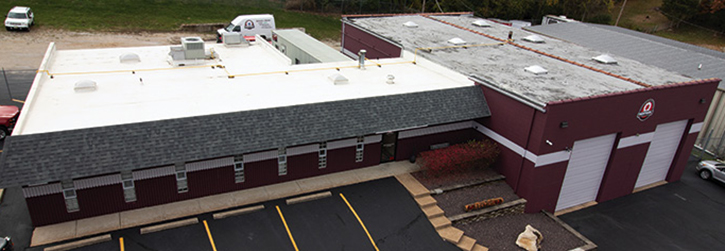
1 This 6,000-square-foot facility in Arnold, Missouri, was purchased in 1995. It will be consolidated into the new Sentinel facility when it is completed. (Photos courtesy of Sentinel Emergency Solutions.)

2 When Franco Emergency Solutions merged with Towers Fire Apparatus in 2013, forming Sentinel Emergency Solutions, the Towers facility in Freeburg, Illinois, became the primary service center for fire apparatus. It also will be consolidated into the new facility.
Bill Franz says, “We were a company working out of our basement, with inventory on homemade plywood shelving. Truly humble beginnings.” The following year, wife Norma bought out the remaining original owner’s shares as well as a portion of Bill’s, and Battalion Three became a woman-owned company. Glenn Agee became Battalion Three’s first full-time nonfamily member employee in 1989. He stills works for the Franz family today.
FIRST MOVES
Bill Franz continues, “Battalion Three moved out of our basement into an 1,800-square-foot space in a small strip mall in 1992. We continued adding employees; however, service work was subcontracted. Three years later, we purchased a 6,000-square-foot building formerly owned by a trucking company located on 11⁄2 acres in Arnold, Missouri. It had two 25-foot-wide × 75-foot-long × 24-foot-high service bays. After renovation, we had a 1,000-square-foot retail store, offices, and service area. We started adding sales representatives and service technicians.”
In 2007, Battalion Three was sold to a New Hampshire entity probably best described as a holding corporation or a so-called consortium that was purchasing small fire equipment dealers throughout the country. Without warning, the consortium closed Battalion Three six months later. The sudden closure effectively sidelined Bill until July of that year because of a noncompete clause. “Shortly after the closing of Battalion Three, Amy and Brian started a new fire equipment company called Franco Emergency Solutions, a limited liability corporation,” says Bill Franz. “In a twist of fate, the same 1,800-square-foot facility occupied by Battalion Three in the early 1990s became available, so Amy and Brian moved Franco into this space.” In July 2008, Bill’s noncompete agreement was fulfilled, and Franco Emergency Solutions moved to the former Battalion Three building in Arnold. The family was back in business.
GRUMMAN AND AMERICAN EAGLE
Bill Franz states, “Initially, Battalion Three was a dealer for Grumman Fire Apparatus; however, after a year of no sales, we switched and became American Eagle dealers. We were familiar with their apparatus as American Eagle was started by former E-ONE employees. My former Chicago-based employer was an E-ONE dealer. In 1988, we sold our first fire truck, an American Eagle on a Ford C-8000, to the Herculaneum (MO) Fire Department. Our second American Eagle sale was a mini pumper to the Antonia (MO) Fire District. Our relationship with American Eagle ended when they were purchased by E-ONE in 1989.”
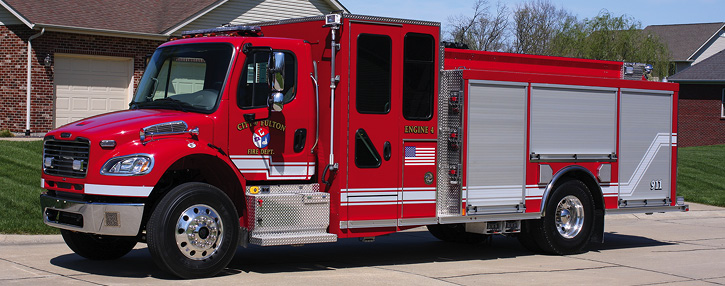
3 The Fulton (MO) Fire Department operates an all-red two-door Freightliner with a standalone Rosenbauer Smart Cab, 1,500-gpm rear-mount pump, 750-gallon tank, and unpainted roll-up doors.

4 The Frontenac (MO) Fire Department runs this 1,500/750 Rosenbauer Crossfire pumper with sealed lever bank controls for pump discharges, three speedlays in a fully enclosed pump house, and a red-black-red paint scheme with graphics.
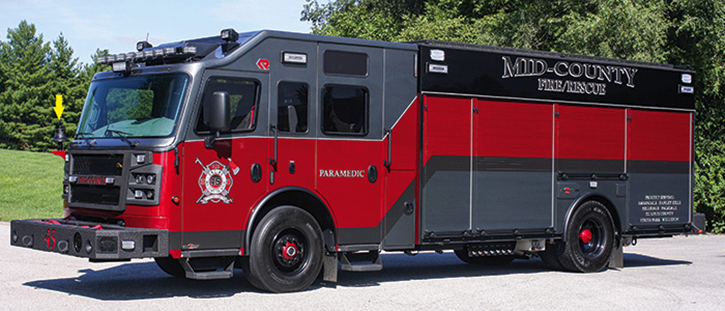
5 This Rosenbauer 1,500/750 Crossfire pumper operated by the Mid County (MO) Fire Protection District sports gray-red paint on the cab and black-red-gray paint on the body. Preconnects are on both front and rear bumpers. The blacked-out feature includes the bell on the cab front.
SAULSBURY
“Our relationship with Alan Saulsbury and Saulsbury Fire Apparatus also started in 1988,” adds Bill Franz. “We sold the first Saulsbury ‘Five Star’ pumper to the Lake St. Louis (MO) Fire District. This was a joint venture between Saulsbury and the chassis manufacturer. It was their first custom cab to be built with the European style open cab configuration.
“The relationship with Alan Saulsbury proved very beneficial both from a financial and business acumen perspective. We put bids together on the Franz family kitchen table. Alan Saulsbury’s direction on business decisions was invaluable. He taught me a lot. I’ve tried to share a lot of his thoughts and ideas with my son, Brian. Alan was truly 25 years ahead of his time! Alan and I put a few rear-mount pumpers in the St. Louis area. When we became a Rosenbauer dealer, we continued to promote them. Brian has picked up on it, taking rear-mounts to the next level.”
BECK AND LTI
After American Eagle closed, Battalion Three picked up Beck Fire Apparatus, which gave it a line of pumpers and brush trucks in addition to Saulsbury’s line of highly specialized custom apparatus and the separate line of Simon-LTI aerial devices. Beck closed shop in 1992, the same year Grumman did. In 1998, Simon-LTI followed, being purchased by Aerial Innovations, Inc. Saulsbury was purchased in 1998 by E-ONE’s owners, who eventually closed it in 2004.
TOWERS AND SENTINEL EMERGENCY SOLUTIONS
Towers Fire Apparatus, in Freeburg, Illinois, began building fire trucks in the 1950s. Around 2000, it ceased manufacturing its own and began selling for other apparatus manufacturers. Towers became the Rosenbauer dealer for Illinois and Indiana in 2011. Franco Emergency Solutions had become a Rosenbauer dealer 10 years earlier, covering eastern Missouri. Despite covering different states, they were only 35 miles apart.
Although they were previously competitors, discussions began to combine the two companies. In August 2013, Towers Fire Apparatus and Franco Emergency Solutions merged operations, becoming Sentinel Emergency Solutions, a limited liability corporation. Two years later, Bill and Brian purchased Brad Towers’s interest in Sentinel Emergency Solutions.
ROSENBAUER
As mentioned, in 2001, Sentinel, formerly known as Franco, and before that as Battalion Three, became the authorized dealer in eastern Missouri for Rosenbauer. Rosenbauer, also a family-oriented business with more than 150 years of manufacturing experience, is the world’s largest manufacturer of fire equipment with 11 manufacturing locations worldwide, four of which are located in the United States.
Bill Franz is the president of Sentinel, and Brian Franz is the vice president. Norma Franz retired from full-time duties but remains somewhat involved. Amy Franz-Schipper works in inside sales. Cindy Franz-Hake is a full-time firefighter/paramedic but provides marketing support. Cindy’s husband Garrett Hake is a mobile service technician. Franz-Hake says, “Sentinel has more than 40 full- and part-time employees covering eastern Missouri, southern Illinois, and Indiana for Rosenbauer territory.”
LOOSE EQUIPMENT
Sentinel represents a multitude of accessory equipment manufacturers. Franz-Schipper says, “We have a separate sales staff of 10 people who sell and provide service for the products we represent. Although restricted (by contract) with some manufacturers, we sell loose equipment in Missouri and southern Illinois.” Franz-Schipper refers to the company’s mission statement: “There’s no grand sales pitch about how we work. It’s perfectly uncomplicated: We sell quality products at a fair price and service what we sell.” Last year, Sentinel put into service two demonstrator vehicles, one specifically for HURST products and another for Task Force Tips products. Sentinel also maintains an online store for equipment sales.
CHICAGOLAND
Rosenbauer recently assigned Sentinel the responsibility to cover the Chicagoland area, which encompasses 16 counties around the Chicago metropolitan area. Brian Franz says, “We are honored that Rosenbauer has the confidence in Sentinel to continue Rosenbauer growth in the Chicagoland area. We are dedicated to all of our customers and will continue building our customer experience with Sentinel. We have dedicated salespeople in Chicagoland and plan to hire more. We also plan to offer mobile service, performing warranty and nonwarranty repairs along with preventive maintenance at the individual firehouses.”
“With Sentinel’s substantial investment with their new headquarters, the decision for Rosenbauer to invest in Sentinel was easy,” says Dave Reichman, Rosenbauer’s national sales manager. “We have a great deal of confidence that the Franz family will grow their business and increase Rosenbauer’s footprint in the Chicago area. They have a great staff and facility and are sure to take care of our customers.”

6 This 101-foot rear-mount Cobra Platform with SMART aerial with 1,750-gpm pump and 500-gallon tank was part of a seven-rig order for the Jefferson City (MO) Fire Department.
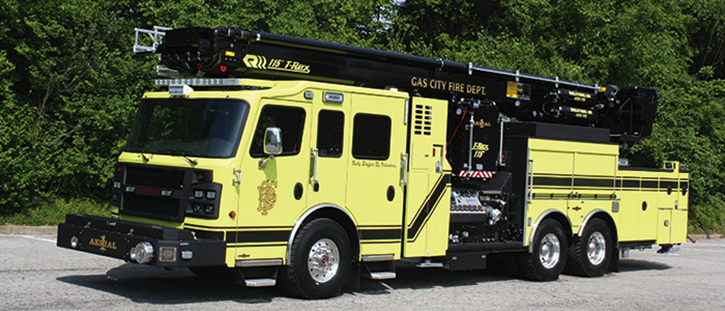
7 The Gas City (IN) Volunteer Fire Department took delivery of a 115-foot T-Rex Rosenbauer aerial device with a 2,000-gpm pump, a 300-gallon tank, and numerous electrically operated valves on its pump panel.
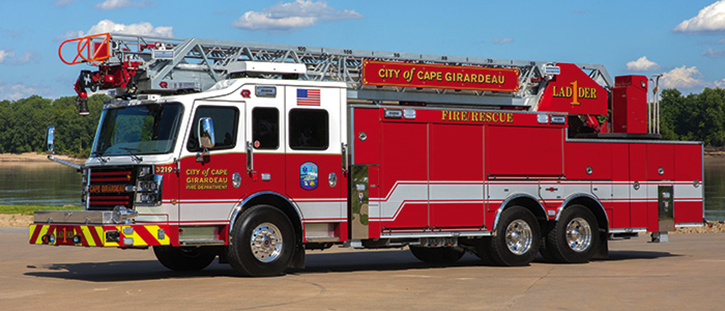
8 This 109-foot Viper aerial, part of a six-rig order for the four-station Cape Girardeau (MO) Fire Department does not have a pump or booster tank. Its ground ladder complement includes a long extension ladder with Bangor poles—an oddity but still a necessity on some of today’s ladder trucks. Compartment doors are a mixture of roll-ups and hinged.
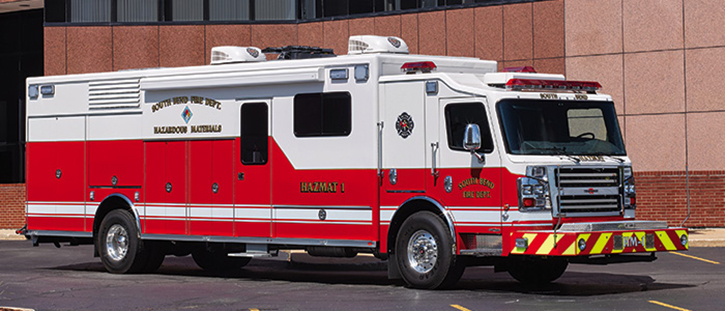
9 The South Bend (IN) Fire Department runs eight Rosenbauers, including this walk-in hazmat rig on a two-door custom chassis. It has hinged doors, a side entry door, a powered awning, and a light tower.

10 The Markle (IN) Volunteer Fire Department took delivery of the first Rosenbauer Avenger pumper in Indiana. It features a 1,500-gpm pump, a 750-gallon tank, a CAFS, and rear bumper crosslays. The upper body side sheets are tapered inward to match the futuristic cab design.
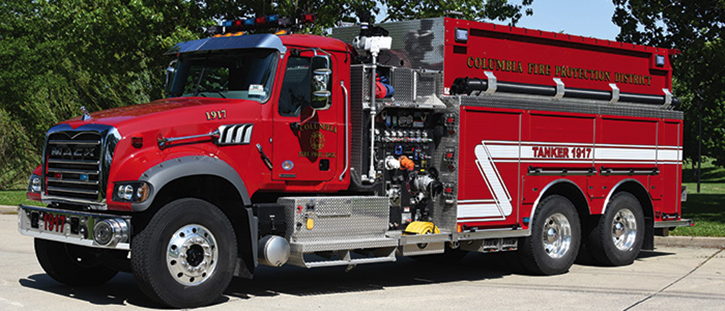
11 One of nine pieces operated by the Columbia (IL) Fire Protection District is this 3,000-gallon Rosenbauer pumper-tanker with a 1,500-gpm pump on a tandem Mack two-door chassis. It has an electric dump valve with a swiveling chute and a powered portable tank rack. Note the extra-long hard sleeve above the side compartments.
INTERVIEW WITH BRIAN AND BILL
How do you describe your customer base? “Probably 40 percent career and 60 percent volunteer. A lot of southern Missouri, Illinois, and Indiana are volunteer. Departments range from full time with 10-plus engine houses to some with only one rig—a 1970s-era first-out pumper. Water supply is a huge problem for many of our customers.”
About how many rigs per year do you sell for Rosenbauer? “25.”
What is your product mix? “We sell every product Rosenbauer has to offer from aerials to tankers, rescues, pumpers, etc. Our most popular product is rear-mount pumpers. With our large rural setting, several customers want a rear-mount for easier operations.” Another popular design is the Crossfire body, which, according to Brian Franz, is: “A crossover between a fully enclosed rear-mount style pumper body and a pumper body with a traditional free-standing pump house with a side control panel. A lot of customers like the look of the rear-mount body but want a traditional midship-mounted pump with a side-mount operator’s panel. The Crossfire fits that need.”
Do you sell ambulances? “No.”
What is the average seating capacity on rigs sold? “Four to five for volunteers; three to four for career departments.”
What is the common pump size you sell? “Usually 1,250 [gallons per minute (gpm)] for volunteers; 1,500 for career departments.”
What is the most common tank size? “1,000 for volunteers; 750 for career departments.”
What is the most common body material? “Aluminum. We occasionally do stainless steel in some areas; however, aluminum is probably 80 percent of our market.”
What are the preferred apparatus color schemes? “We like to be unique and change what’s ‘normal.’ We do a lot of black or gray over red but have also done unique colors such as gray over blue, red over black, and even three-tone paint jobs.”
Do you market many aerial devices without pumps? “No, the only true ladder truck we’ve ever sold was to the City of Cape Girardeau (MI) Fire Department in 2017. Midwest departments commonly run aerials with pumps.”
What are the most common aerial devices you sell? “Rosenbauer’s Viper aerials, 78-foot and 109-foot, as well as their 100-foot Cobra Platforms both mid and rear-mount versions.”
Have any customers recently purchased a 45-foot or 50-foot Bangor extension ladder? “Cape Girardeau, Missouri, has one on their 109-foot aerial. No other departments have them on new trucks.”
What’s the split between walk-in and walk-around rescue trucks? “50/50.”
Do you sell more custom or commercial chassied pumpers? “Custom.”
How receptive are customers to the new Avenger chassis? “Whenever new products and designs are introduced, there is always a degree of apprehension and skepticism shown by die hard traditionalists in the fire service. Prime examples were the introduction of fully enclosed four-door cabs, sexless couplings, and large-diameter supply hose. The features designed into the stylistic Avenger series are intended to improve those found in the existing so-called traditional styled cabs. Many departments where we showcase the Avenger understand that premise. It’s the same thoughts on apparatus with no chrome and the new ‘blacked out’ concept.”
Do you sell many straight tankers? “We sell more ‘pumper-tankers’ than true tankers (tenders) with no pumps. Some departments purchase a 2,000- or a 3,000-gallon tanker with a small 500-gpm pump.”
Do you sell many mini pumpers? “Not really. We only had one on order for 2019.”
Are rigs compliant only with NFPA 1906, Standard for Wildland Fire Apparatus, common in your territory? “No.”
Are wildland urban interface rigs popular? “They are not too popular in our area. We’ve sold two Rosenbauer Timberwolfs over the past five years.”
NEW FACILITY
Was the new facility designed by Sentinel staff? “The new building design has definitely been a team effort, especially when it comes to the service department. We made it clear to our team that their opinions do matter, and if they have any ideas for the new location, we are always open. We did not have a template for the design. We literally threw everyone’s ideas together and worked with an architect to design it.”
How big is the service area? “It is 3,400 square feet, with 10 service bays dedicated to repairs only on fire apparatus. Four additional bays are dedicated to our body shop and include a 60-foot-long by 20-foot-wide paint booth with a 16-foot-high ceiling.
“Our entire facility is really exciting, and we have some areas that we feel are unique. We have a dedicated delivery bay for new trucks. Connected to the delivery bay is a conference room for preconstruction meetings and customer inspections. There’s a ‘service write-up bay,’ so when customers bring their trucks in for service, they pull inside of the building and discuss their repairs with our service writer. We also have a customer waiting area, a second-story training center, a two-story parts mezzanine with over 8,000 square feet in our parts warehouse, and a 1,200-square-foot retail store.”
Why did you consolidate locations? “With the rapid growth of Sentinel Emergency Solutions over the past five years, the consolidation is much needed. The staff at both offices have done very well with overcoming the difficulty of not being under one roof. With the new location, this will make daily operations much easier. Having our administrative office and sales in one location with service only at the other made daily operations difficult.”
SERVICE
How many on-the-road service vehicles do you have? “Currently six, with another on order that should be on the streets in 2020.”
How many employees are in the service department? “Currently, there are 12 people; however, with our fast growth, we are always looking for techs. All of our technicians are constantly learning and gaining [emergency vehicle technician (EVT)] certifications. We believe firmly in EVT and are dedicated to the fire industry.
“All of our service staff from the manager to the technicians have experience in their specific job functions. Our technicians undergo extensive training through Rosenbauer, pump manufacturers, etc. We encourage our techs to continuously learn by taking EVT or other CEU courses for repairs and maintenance as well.”
ONE-ON-ONE WITH BRIAN FRANZ
Is cooperative purchasing popular in your territory? “Absolutely. All three of the states we cover utilize co-op purchasing in some way. It’s a great way to purchase vehicles and a simpler process for the customer. It allows us salespeople to play our cards face up and talk pricing through the entire process. There’s nothing worse than working with a customer on their dream truck only to find out at the bid opening that it’s nowhere near their budget amount.”
Do fire departments write their own specs or use outside sources? “They write their own specifications the best they can. Many departments try to take several manufacturers’ specifications and combine them into one purchasing document. The problem with this is the various pieces don’t always fit together. Different manufacturers build trucks in different ways, so there is no way to meet that particular type specification 100 percent.”
Is there a tendency for municipalities to take low bid without forcing bidders to adhere to the department’s purchasing specifications? “Absolutely. Some cities require the fire department to take the lowest bidder no matter what. Unfortunately, when this happens, the fire department doesn’t get what it wants, and manufacturers are only worried about being low bid. We at Sentinel aren’t good in these situations. We are interested in selling quality products for a fair price and servicing what we sell. We are looking for long-term relationships with customers who want to buy our trucks and work with us into the future.” Brian reiterated the company’s mission statement alluded to by Franz-Schipper above, which is on Sentinel’s Web site: “There’s no grand sales pitch about how we work. It’s perfectly uncomplicated: We sell quality products at a fair price and service what we sell.”
Do fire departments’ purchasing specifications require specific service capabilities for the bidders? “Various areas in our territory have different concerns with this. We have cities that are very concerned with a brick-and-mortar service center and put more of an emphasis in their bid documents for it. However, we also cover a large rural area that is more concerned with mobile service than a shop. With our large volunteer area, they don’t have time to take it to an outside facility, which is why our mobile service business is growing rapidly.”
Is there a trend toward environmentally clean crew cabs? “Yes, there’s still some apprehension about what it entails. Every agency wants to be cleaner/healthier, but unfortunately in this industry, there’s no defined way to do it.”
Is there a concern in your territory about the “brightness” of LED warning lights? “Yes. Several departments would like a ‘dimming’ feature installed on their apparatus, but with NFPA that’s an issue. We have tried to limit the amount of warning lights and even change to smaller lights, but the intensity is still there.”
Is there a trend toward multipurpose vehicles such as pumper-rescues and quints? “Yes. We’ve seen this trend for the past several years, and it continues to grow. With manpower issues both in the paid and volunteer world, combining trucks together seems to work.”
Do you have any words of wisdom for new purchasers of fire apparatus? “Do your homework when purchasing your next apparatus. Get what you want, and don’t settle for what a vendor says ‘you need.’ We work with many fire departments, and I tell them this at every meeting: ‘It’s my job to bring up new ideas and trends. You have to live with your new rig, so specify it to fit your needs.’ ”
BILL ADAMS is a member of the Fire Apparatus & Emergency Equipment Editorial Advisory Board, a former fire apparatus salesman, and a past chief of the East Rochester (NY) Fire Department. He has 50 years of experience in the volunteer fire service.

